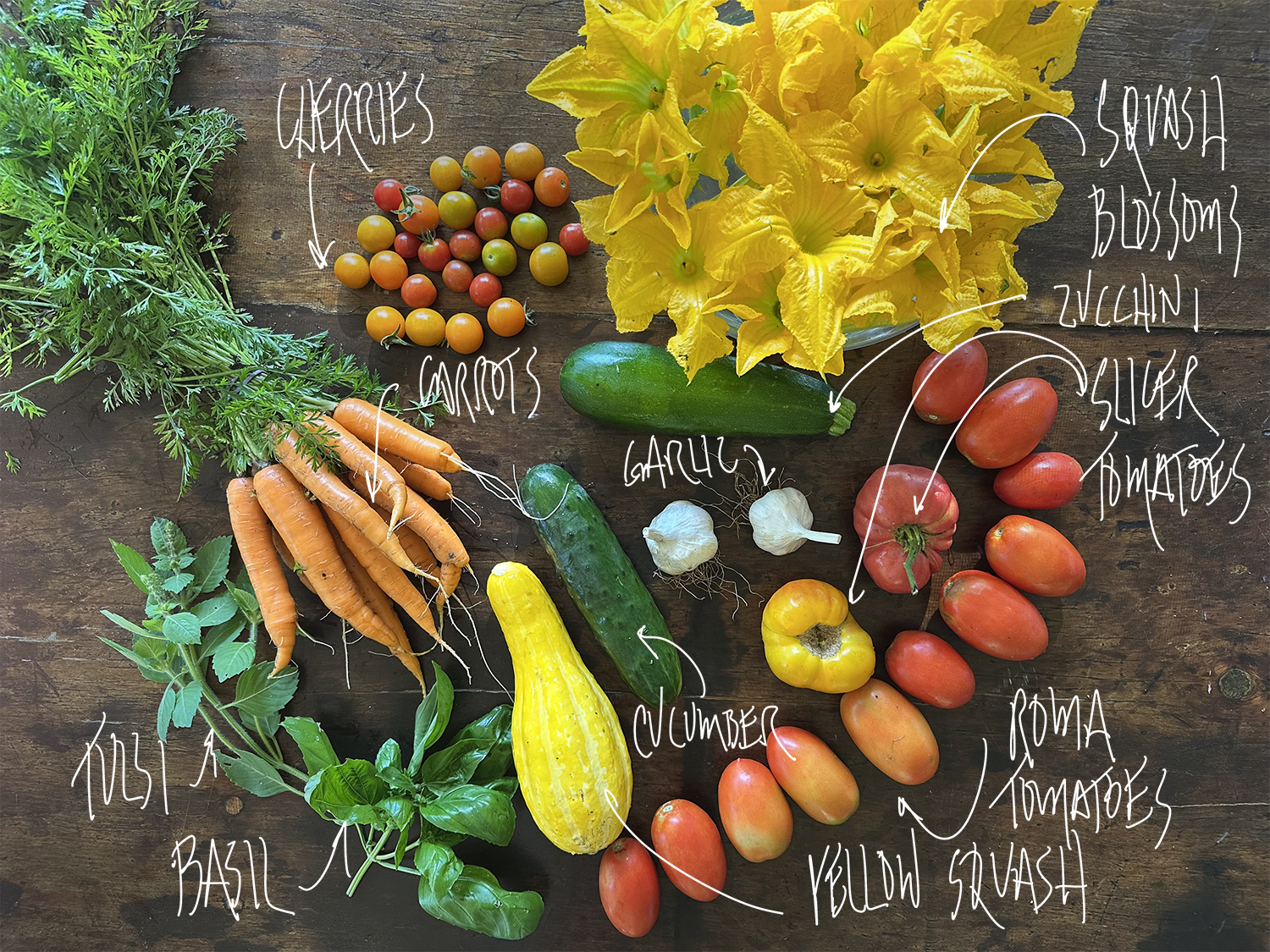2025 Season | Week 12
Hump Week
We’re halfway through the 2025 season. This week, carrots are back, and for those who’d like to try a delicacy, squash blossoms. In the words of famous food forager, outdoorsman, and early health food advocate, Euell Gibbons, “some parts are edible.” Here’s a little info from our AI friends:
Squash blossoms are a delicate and flavorful seasonal treat packed with nutritional benefits. Rich in vitamins A and C, iron, and calcium, they also provide antioxidants and fiber while being low in calories. Their mild, slightly sweet flavor makes them incredibly versatile in the kitchen. One of the most popular ways to enjoy squash blossoms is to stuff them with ricotta or goat cheese, lightly batter them, and fry them until crisp. They can also be sautéed and added to pasta, folded into quesadillas, or used to top flatbreads and pizzas. To prepare them, gently rinse and pat dry, then remove the inner stamen or pistil. Please handle with care, as they tear easily. Whether served fresh in a salad or warm and melty from the pan, squash blossoms bring a unique and elegant flair to summer dishes.
For those you’d like to try the blossoms, we’ll have some in water in the trailer. Help yourself and put them back in water as soon as you get home.
Also new this week, my fifth grandchild sprouted and her name is Fern Charlie. She lives in St Paul, MN, but will be coming to visit the farm in October. Haley, Chad, and Fern are doing well and are headed home from the hospital later today.
Have a good week.
-
CARROTS 101 - Crunchy, tasty, and highly nutritious, carrots are one of our favorite root vegetables. Carrots are a great source of beta carotene, fiber, vitamin K1, potassium, and antioxidants! We’re used to seeing orange carrots, but did you know carrots come in a variety of colors like yellow, white, red, and even purple? Both the root and the greens are edible - the leaves make for a great garnish or addition to pesto. The greens have a slightly bitter taste that compliments the sweetness of the root.
EAT NOW - Because we don’t use pesticides, our carrots don’t need to be peeled. Simply rinse and scrub any dirt before use. Eaten raw, carrots are great whole, julienned, speared, or chopped. Carrots can be boiled, sautéd, stir fried, or even air fried! Fresh carrot tops can be chopped into a green salad or stir-fry too! The greens can also be dried and used as an herb like parsley.
OR LATER - To avoid “floppy carrots,” remove the green tops as soon as you can, leaving about an inch of stems. Save the greens separately. Then, place root in a bag in the fridge or in a bin of water (like celery) to keep them crisp, changing out the water every few days. Uncut carrots will last in the fridge for up to 4 weeks. They can also be chopped, then blanched and placed in an airtight container in the freezer to keep longer. Store the tops in a separate bag in the fridge. Or put them in a plastic Ziplock in your freezer and use them to make DIY vegetable or chicken stock.
To blanch, bring a pot of lightly salted water to a rolling boil. While you wait for boil, prepare an ice bath. Once boiling, drop veggies into water - water should return to boil within a minute otherwise you have too much veg for the water. Once boil has returned, cook for 1-5 min until veg has a vibrant color. Immediately put into ice bath to stop cooking.
RECIPIES
-
Cucumber 101
Crisp, cool, and incredibly refreshing, cucumbers are a staple summer vegetable (technically a fruit!) known for their high water content and mild flavor. They belong to the gourd family and are rich in hydration, vitamin K, and antioxidants. Whether you choose slicing cucumbers or smaller pickling varieties, they add crunch and freshness to almost any dish.Eat Now
Enjoy cucumbers raw—just wash, slice, and snack. Add to salads, sandwiches, or enjoy with a sprinkle of sea salt or a splash of vinegar. For a cooling treat, slice into water with lemon and mint for a spa-style drink.Eat Later
Store whole cucumbers in the fridge, preferably in the crisper drawer, for up to a week. Once cut, wrap tightly in plastic or place in an airtight container to maintain moisture and crunch. Avoid storing near ethylene-producing fruits like bananas, which can cause premature spoilage.Recipes
Cucumber Salad: Toss sliced cucumbers with red onion, rice vinegar, sesame oil, and a pinch of sugar for a quick Asian-inspired salad.
Tzatziki Sauce: Grate cucumber and mix with Greek yogurt, garlic, lemon, and dill for a tangy, creamy dip.
Chilled Cucumber Soup: Blend cucumbers with yogurt, mint, and a splash of lemon juice for a refreshing summer soup.
-
Fresh Garlic 101
Fresh-harvested garlic, also known as “wet” or “green” garlic, is garlic that’s been pulled from the ground before it’s fully cured. Unlike the dry, papery bulbs you find in the store, fresh garlic has moist skins, juicy cloves, and sometimes green stalks still attached. The flavor is milder and more delicate than cured garlic, with a slightly grassy, almost sweet note—perfect for early summer cooking.Eat Now
Use fresh garlic anywhere you’d use regular garlic, but celebrate its tenderness! Slice or mince the cloves for sautés, salad dressings, or marinades. The juicy cloves melt beautifully into sauces, and the mild flavor makes it a lovely addition raw in dips or spreads. If the stalks are still soft, you can treat them like scallions—chop and toss into stir-fries, soups, or omelets.Eat Later
If you’re not using it right away, store fresh garlic in a cool, dry spot with good airflow. It won’t last as long as cured garlic—typically a few weeks—so keep an eye on it. To preserve the harvest, you can cure the garlic yourself by allowing it to dry for a few weeks, or peel and freeze the cloves for longer storage. Roasting and storing in oil (with proper safety precautions) is another delicious way to enjoy fresh garlic down the road. -
SQUASH 101 - Because of their bland flavor, summer squash lend themselves to many cooking applications, taking on the flavor of whatever they’re cooked with. Try using them as a substitute for rice, pasta or potatoes. Or, slice tender, young squash into salads, stir-fries, or with pasta. The are also great on the grill!
EAT NOW - Gently scrub away dirt. Slice off the tops. Can be roughly chopped, sliced, or grated for a variety of recipes from steamed to stuffed to stir-fried!
OR LATER - Store squash unwashed in a perforated plastic bag in the vegetable bin for about a week and a half. Freeze pureed (seeded) zucchini in Ziplock bags, and grated zucchini for use in breads and muffins.
RECIPE
-
TOMATOES 101 - Probably the most versatile fruit in the garden, tomatoes can be used in countless ways - salsa, gazpacho, sauces, slow roasted, puree and even a bloody Mary. Ours are grown for taste so eat them right out of the crate.
EAT NOW - Store unripe tomatoes upside down on a plate at room temperature until they fully ripen. Wash, pat dry, slice or dice, and enjoy the taste of a real tomato.
OR LATER - Refrigerate any fully ripe tomatoes - allow to come to room temp before serving. To freeze, first blanch and dunk in ice water to cool. Remove stems and core. Transfer to storage bags, seal and place in freezer.
To blanch, bring a pot of lightly salted water to a rolling boil. While you wait for boil, prepare an ice bath. Once boiling, drop veggies into water - water should return to boil within a minute otherwise you have too much veg for the water. Once boil has returned, cook for 1-5 min until veg has a vibrant color. Immediately put into ice bath to stop cooking.
RECIPES





